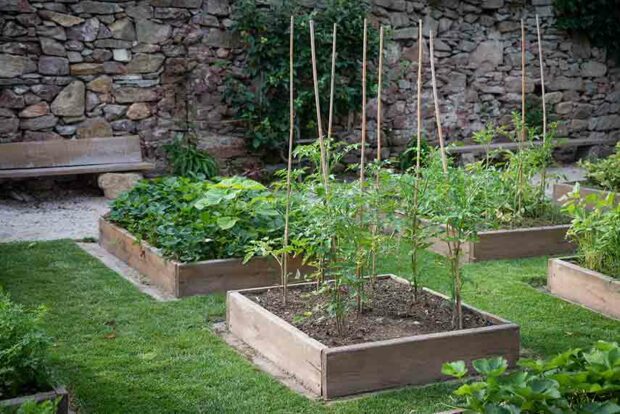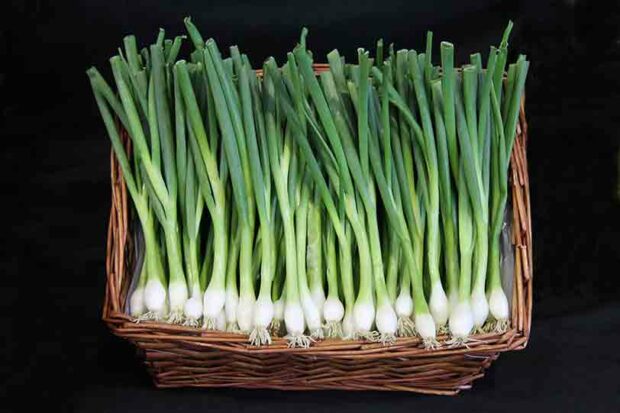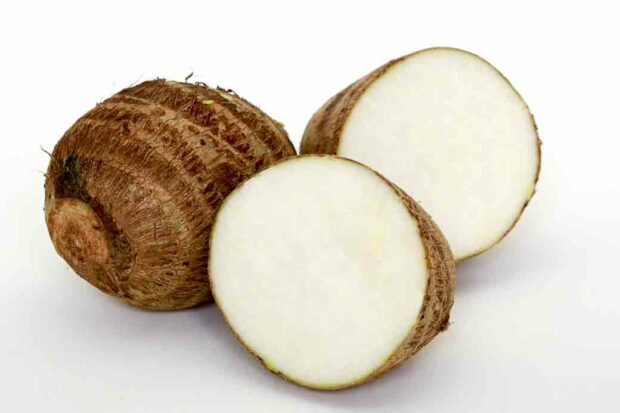10 Crops You Can Grow Easily in Your Home Garden
Published on: September 19, 2021 (Updated on: April 22, 2024)

Have you ever thought of growing crops of your own? Well, it's totally achievable and you don't necessarily need to buy a land somewhere to achieve this. You can grow your own crop right in your garden. This post will show you 10 crops you can grow easily in your home garden with the right methods. Imagine not having to purchase vegetables from the grocery store again with different crops growing in your garden. You can always choose from the variety of crops growing in your garden whenever you need it.
Below are 10 Crops you can grow easily in your home garden
1. Spinach
Spinach is usually found as a healthy side dish on the dinner plate and is particularly nutritious because of its comparatively high iron content. Spinach grows better in cold climates and it's one of the best home garden crops.
It is usually sown about 30cm directly below the ground. The seedlings should be placed about half an inch apart from one another. When the seedlings sprout and shows their first leaf, they can be separated and placed about 10 to 12 inches apart. As the seeds grow, the soil in which they are planted should be kept moist.
2. Tomatoes
Amongst crops you can grow easily in your garden, tomatoes are perhaps the easiest. They are one of the tastiest and most popular vegetables. They are available in a wide variety of colors, shapes and flavors.
Tomatoes need nutrient-rich and well-drained garden soil, they cannot tolerate waterlogging. The location they are planted should be sunny, sheltered from the wind and covered.
If you don't have a garden, you can easily grow tomatoes on the balcony. You can grow it in a tub or simply in a planter bag.
3. Peas
This is another great crop you can grow easily in your garden. The germination time varies from 10 to 15 days if the temperature oscillates between 12 and 15 ° C approximately, but the temperature ideal for its good growth is to have 18 to 23 ° C during the day and 7 to 10 ° C at night. In colder regions, although the leaves of the pea resists frosts of -5 to -10 ° C, it is possible to sow in a plastic tunnel which will be removed as soon as the peas are good to stop.
While peas can grow in almost any land, they prefer light, cool, well-aerated soils to a depth of at least 15 cm. Acidic, too wet, or too chalky soils will not provide good pea yields.
In short, the pea is delicate when sowing because the ideal conditions are not easy to meet. The conditions include; mild climate but not too hot either, humidity but not too much moisture.
Your peas should be sown in a perfectly sunny area of your garden, if possible, which collects the heat from which the humus soil does not dry out easily. The pea stores nitrogen from the air at its roots, so it is not necessary to add nitrogen fertilizer.
There are two sowing techniques: either you put a seed every 2-3 cm, or you put 6-8 seeds in pockets every 30 cm. The seeds should be buried 1.5 cm.
Install wire mesh, or even oars for dwarf peas whose tendrils need to attach. Also mulch the soil to keep the freshness, water regularly but not too much so as not to saturate the soil with water, without wetting the leaves, to avoid powdery mildew.
4. Spring onion

Another crop that can be easily planted in your garden is spring onion. Spring onion is native to the Orient. Like the name suggests, it is actually related to onion. In temperate regions, spring onions can be harvested year round. In the kitchen, there is hardly any limit to its variety of jobs. And of course, a meal with onions from your own garden is tasty.
To plant this crop in your garden, use the handle of your hook to draw fine furrows in the flower bed at intervals of about 8 inches.
Sow the onion seeds in the furrow, spacing them 2 to 3 cm. The seeds should not be too close to each other, as the bulbs should be able to develop. Lightly cover the seeds and water them gently. In case of drought, moisten the bed regularly. About 10 days after sowing, the first shoots appear. After about a month, or sooner depending on growth, you can plant them outside.
5. Cassava
Cassava is a very great crop to have in your garden. It is also very easy to grow this crop. Cassava is a perennial crop. You can plant it by building heaps of soil and then placing a branch broken from another cassava crop within the heap so that it sticks out.
Cassava does well in places with good rainfall distribution, from 1,000 to 1,500 millimeters per. But in tropical regions, production grows at up to 4,000 millimeters per year, without the occurrence of a dry season. In this case, the soil must be well drained, as waterlogging rots the roots. In semi-arid areas, with 500 to 700 millimeters of rain a year, it is necessary to have an abundance of water for at least the first five months of cultivation.
6. Yam

Yam is seldom included on the list of crops you can grow at home. This is because, not many people know about yam. It is very similar to cassava and it is a great crop to have in your garden. It should be planted in the open, in cool, deep, light, fertile soil, well loosened and rich in humus. The soil must be very loose if you want to recover the large and long tuber at the end of the season.
To plant yam in your garden, you should make rows of ridges, depending on the amount of yam you wish to plant. Then cut the bottom or topmost part of your yam tuber and place it not so deeply into your heap. Ensure that it gets enough water, and don't let the yam be exposed to air. Make sure it is covered by the sand completely. As the yam tendrils grow, you might need to erect long poles next to them so that the yam tendrils can creep upwards.
7. Pepper
Pepper can enhance food taste and it is one of the best crops you can grow at home. Pepper seeds germinate very well when the ambient temperature is around 26ºC . If left in a cold place, the best option is to use a heated germinator to reach the ideal germination temperature. The idea is to place the germinator inside the house and next to a window that guarantees us the sun. In this way we will have the seeds protected from the cold outside and you can bring forward the pepper season.
After some time, you can start germinating them in an unheated germinator. Place 2-3 seeds per seedbed, then you should only have one, the largest and strongest.
Keep the humidity inside the germinator until the plants grow 2 leaves, at that time, light and ventilation will be priority, place the germinator in a light place and open the ventilation windows.
When you have the first plants, we must wait until the soil in your garden, where you are going to transplant the peppers, has a temperature of 18ºC. Otherwise we run the risk that the pepper seedling will not survive during transplant.
8. Garlic
Garlic be grown in your garden. To plant, bury them about 2-3 cm and cover them with soil without tamping. In turn, sow them at a distance of 10-15 cm from each other
Once buried, they are given a first gentle watering and from that moment, they usually take about 2 weeks just to germinate .
Garlic tends to rot easily, so watering should be moderate to little in case of constant rainfall. But if you are from a dry area, moderate watering every week will be more than enough. It is very important that the soil where the garlic is planted does not puddle and does not add excess fertilizer.
You should also have to remove the weeds that grow around the garlic.
Stems with a flower will come out in early or mid-spring. If you let the flower grow, the garlic will absorb all the nutrients towards it and it will "neglect" the size of the bulb, so you are going to cut it. With one hand, firmly hold the stem of the garlic, to prevent it from detaching from the ground and with the other, pull the flower stem and the latter is going to be cut.
9. Beetroot
Beetroot can be sown from scratch or planted from young plants bought in stores. Beets are very easy to grow in your garden.
Beetroot appreciates rather rich soils. It is advisable to enhance the soil beforehand with a fertilizer such as manure and algae mixed with the soil. This step is the guarantee of having beautiful and delicious beets when harvested.
Beet growth is rapid since it occurs only 10-12 days after sowing the seeds.
To sow, make sure there is no frost, or protect them, if necessary, with a plastic tunnel. Dig a furrow 2 cm deep. If you have several furrows, space them about 40 cm apart. Sow 2-3 seeds every 25 cm or so. Then water it regularly.
10. Runner beans
This list of crops you can grow easily in your home garden would be incomplete without mentioning runner beans. To plant these beans, moisten the beans a little before taking them to the ground, because this plant should feel comfortable in environments where humidity predominates.
The best thing to do is to sow them for the first time in a glass or plastic container, in a kind of germinator, to ensure that the growth is assured.
Before transplanting, do not forget that the earth should be moistened and that the sun ought to shine on it most of the day. It is imperative that you carry out these steps in times when it is not too cold or too hot.
This is my list of 10 crops you can grow easily in your home garden. Although you can plant these crops within your garden. However, your location, as well as the climate and other factors like the soil type and texture will ultimately determine whether or not these crops would grow properly.